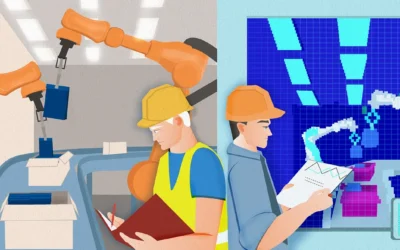Wulf, Jochen; West, Shaun; Anderson, Matthew; Mueller-Csernetzky, Petra; Meierhofer, Juerg
On the Value Potential of Large Language Models in the Manufacturing Industry Working paper
2025.
@workingpaper{wulf2024,
title = {On the Value Potential of Large Language Models in the Manufacturing Industry },
author = {Jochen Wulf and Shaun West and Matthew Anderson and Petra Mueller-Csernetzky and Juerg Meierhofer},
url = {https://papers.ssrn.com/sol3/papers.cfm?abstract_id=5061215},
doi = {https://ssrn.com/abstract=5061215 or http://dx.doi.org/10.2139/ssrn.5061215},
year = {2025},
date = {2025-02-06},
urldate = {2025-02-06},
abstract = {This study explores the integration of Large Language Models (LLMs) into the manufacturing sector, focusing on their potential to enhance efficiency, decision-making, and product quality. While existing literature emphasizes the conceptual benefits of LLMs, there is limited empirical evidence supporting these claims. The study uses a case study to examine five affordances of LLMs, including automating information processing and improving data quality, as well as four constraints, such as risks to job stability and data security. Key findings suggest that LLMs offer substantial opportunities for streamlining operations and reducing manual labor, yet challenges such as explainability and secure data management remain. The study contributes to both theory and practice by advancing the understanding of LLM integration in manufacturing through an affordance theory framework. This framework helps assess how LLMs influence operational processes and workforce dynamics. However, the study acknowledges its limitations due to the reliance on early-stage data and a single case study, urging further research into diverse industrial settings and long-term effects.},
keywords = {},
pubstate = {published},
tppubtype = {workingpaper}
}
This study explores the integration of Large Language Models (LLMs) into the manufacturing sector, focusing on their potential to enhance efficiency, decision-making, and product quality. While existing literature emphasizes the conceptual benefits of LLMs, there is limited empirical evidence supporting these claims. The study uses a case study to examine five affordances of LLMs, including automating information processing and improving data quality, as well as four constraints, such as risks to job stability and data security. Key findings suggest that LLMs offer substantial opportunities for streamlining operations and reducing manual labor, yet challenges such as explainability and secure data management remain. The study contributes to both theory and practice by advancing the understanding of LLM integration in manufacturing through an affordance theory framework. This framework helps assess how LLMs influence operational processes and workforce dynamics. However, the study acknowledges its limitations due to the reliance on early-stage data and a single case study, urging further research into diverse industrial settings and long-term effects.
Anderson, Matthew; West, Shaun; Wood, Bruce
The Smart Factory as an Operational Asset—Use of Visual Twins to Improve Factory Operational Performance Book Chapter
In: 2024, ISBN: 978-3-031-60312-9.
@inbook{anderson2024,
title = {The Smart Factory as an Operational Asset—Use of Visual Twins to Improve Factory Operational Performance},
author = {Matthew Anderson and Shaun West and Bruce Wood},
url = {https://link.springer.com/book/10.1007/978-3-031-60313-6
https://www.researchgate.net/publication/382606508_The_Smart_Factory_as_an_Operational_Asset-Use_of_Visual_Twins_to_Improve_Factory_Operational_Performance},
doi = {https://doi.org/10.1007/978-3-031-60313-6_16},
isbn = {978-3-031-60312-9},
year = {2024},
date = {2024-07-27},
urldate = {2024-07-27},
journal = {Progress in IS},
abstract = {Adaptation and clear visualization of factory operations are crucial in the industrial sector. This research presents the “Visual Twin,” a tool offering detailed insights into facility inefficiencies, emphasising flow and space. It has developed using advanced 3D scanning and integrates multiple manufacturing elements, promoting flexibility and adaptability. The Visual Twin facilitates a shift in perspective, viewing the factory as an operational asset and introducing option spaces for optimal factory floor organization. This method seeks to refine workflow, enhance efficiency, and align with specific operational needs and manufacturing goals, aiming to improve overall operational efficiency, productivity, and profitability. The examples reveal the significant impact of adopting a modular and multi-service architecture, promoting rapid responses to innovation needs.},
keywords = {},
pubstate = {published},
tppubtype = {inbook}
}
Adaptation and clear visualization of factory operations are crucial in the industrial sector. This research presents the “Visual Twin,” a tool offering detailed insights into facility inefficiencies, emphasising flow and space. It has developed using advanced 3D scanning and integrates multiple manufacturing elements, promoting flexibility and adaptability. The Visual Twin facilitates a shift in perspective, viewing the factory as an operational asset and introducing option spaces for optimal factory floor organization. This method seeks to refine workflow, enhance efficiency, and align with specific operational needs and manufacturing goals, aiming to improve overall operational efficiency, productivity, and profitability. The examples reveal the significant impact of adopting a modular and multi-service architecture, promoting rapid responses to innovation needs.
Majid, Asif; Anderson, Matthew; Khan, Mohammed; Milisavljevic-Syed, Jelena; West, Shaun; Wood, Bruce
Impact of Organizational Culture on shifting towards a Servitization strategy Conference
conference paper Servitization forum in Finland, 2023, ISBN: ISBN: 978 1 85449 816 8.
@conference{Anderson2023b,
title = {Impact of Organizational Culture on shifting towards a Servitization strategy},
author = {Asif Majid and Matthew Anderson and Mohammed Khan and Jelena Milisavljevic-Syed and Shaun West and Bruce Wood},
url = {https://www.researchgate.net/publication/370609501_Impact_of_Organizational_Culture_on_shifting_towards_a_Servitization_strategy
https://mattanderson.ch/wp-content/uploads/IMPACT-OF-ORGANIZATIONAL-CULTURE-ON-SHIFTING-TOWARDS-A-SERVITIZATION-STRATEGY.docx-3.pdf},
isbn = {ISBN: 978 1 85449 816 8},
year = {2023},
date = {2023-12-13},
urldate = {2023-12-13},
booktitle = {conference paper Servitization forum in Finland},
abstract = {Purpose: To review papers relating to servitization and culture to develop a framework by identifying the key cultural characteristics/factors underpinning a successful transition to a servitization based business model. Design/Methodology/Approach: A Systematic Literature Review (SLR) was conducted, which identified relevant papers on servitization, culture, and change management frameworks. Further analysis on the key cultural characteristics/factors was established based on the reviewed papers. Findings: Synthesis from adjacent change literature of an initial Organizational Culture framework to facilitate the shift to servitization. Identification of contributory dimensions that may impact this transformation. To be followed by further empirical research. Originality/Value: The successful implementation of a Service based strategy is highly influenced by organizational cultures. Managerial awareness of the contributory dimensions via the application of a theoretical framework will improve these efforts.},
keywords = {},
pubstate = {published},
tppubtype = {conference}
}
Purpose: To review papers relating to servitization and culture to develop a framework by identifying the key cultural characteristics/factors underpinning a successful transition to a servitization based business model. Design/Methodology/Approach: A Systematic Literature Review (SLR) was conducted, which identified relevant papers on servitization, culture, and change management frameworks. Further analysis on the key cultural characteristics/factors was established based on the reviewed papers. Findings: Synthesis from adjacent change literature of an initial Organizational Culture framework to facilitate the shift to servitization. Identification of contributory dimensions that may impact this transformation. To be followed by further empirical research. Originality/Value: The successful implementation of a Service based strategy is highly influenced by organizational cultures. Managerial awareness of the contributory dimensions via the application of a theoretical framework will improve these efforts.
Anderson, Matthew; Romero, David; West, Shaun; Harrison, David
Communicating the Value of Digital Transformation within Manufacturing Firms Book Chapter
In: Smart Services Summit - Progress in IS , Zurich, 2023.
@inbook{nokey,
title = {Communicating the Value of Digital Transformation within Manufacturing Firms},
author = {Matthew Anderson and David Romero and Shaun West and David Harrison},
url = {https://www.researchgate.net/publication/373455495_Communicating_the_Value_of_Digital_Transformation_Within_Manufacturing_Firms},
doi = {http://dx.doi.org/10.1007/978-3-031-36698-7_2},
year = {2023},
date = {2023-01-31},
urldate = {2023-01-31},
booktitle = {Smart Services Summit - Progress in IS },
address = { Zurich},
abstract = {Digital Transformation provides both value creation and co-creation opportunities within manufacturing firms, enabling these to develop new and more efficient ‘digitally-enabled’ value propositions. However, there remain notable gaps in communicating these digital opportunities (value) throughout a firm, creating barriers to justifying this type of transformation, and limiting their adoption. The purpose of this paper is to explore this gap, using input from three industrial case studies, and to create a framework that recognises relevant metrics to identify and communicate this (digital) value. The findings from these case studies highlight the importance of translating metrics between different levels of a firm and communicating visually these to better appreciate the new digitally[1]enabled value (co-)creation process.},
keywords = {},
pubstate = {published},
tppubtype = {inbook}
}
Digital Transformation provides both value creation and co-creation opportunities within manufacturing firms, enabling these to develop new and more efficient ‘digitally-enabled’ value propositions. However, there remain notable gaps in communicating these digital opportunities (value) throughout a firm, creating barriers to justifying this type of transformation, and limiting their adoption. The purpose of this paper is to explore this gap, using input from three industrial case studies, and to create a framework that recognises relevant metrics to identify and communicate this (digital) value. The findings from these case studies highlight the importance of translating metrics between different levels of a firm and communicating visually these to better appreciate the new digitally[1]enabled value (co-)creation process.
West, Shaun; Ebel, Martin; Anderson, Matthew; Stoll, Oliver; Poeppelbuss, Jens; Khan, Muztoba
Nested Lifecycles-Improving the Visibility of Product Lifespans in Smart Factories Journal Article
In: Frontiers in Manufacturing Technology, vol. 2, iss. April 2022, 2022.
@article{West2022,
title = {Nested Lifecycles-Improving the Visibility of Product Lifespans in Smart Factories},
author = {Shaun West and Martin Ebel and Matthew Anderson and Oliver Stoll and Jens Poeppelbuss and Muztoba Khan},
url = {https://doi.org/10.3389/fmtec.2022.837478, read online
https://www.frontiersin.org/articles/10.3389/fmtec.2022.837478/pdf, download pdf},
year = {2022},
date = {2022-04-25},
urldate = {2022-04-25},
journal = {Frontiers in Manufacturing Technology},
volume = {2},
issue = {April 2022},
abstract = {Within the smart factory environment, we have a complex system of systems composed of Industry 4.0/digital technologies and assets with varying lifespans. Different degrees of innovation maturity and different lifespans of integrated assets within the industrial internet of things (IIOT) are considered problematic and lead to different perspectives on asset lifecycles as they impact significantly on the asset lifespans. This leads to the loss of a clear end-of-life phase defined in existing Product Lifecycle Management (PLM) models. Through an integrative literature review, this study introduces the concept of nested lifecycles that takes a systems perspective to asset management, and considers subsystems with different lifespans that must be managed holistically by different actors with different perspectives. Additionally, this study provides a framework to derive strategies for lifecycle management by allowing the nested lifecycles to be clearly identified and then addressed. From the theoretical perspective, the notion of nested lifecycles provides a novel viewpoint for the asset management and PLM research community. From the managerial perspective, the proposed framework will help managers identify why and where collaboration between different actors may create difficulties due to their varying outlooks and training.},
keywords = {},
pubstate = {published},
tppubtype = {article}
}
Within the smart factory environment, we have a complex system of systems composed of Industry 4.0/digital technologies and assets with varying lifespans. Different degrees of innovation maturity and different lifespans of integrated assets within the industrial internet of things (IIOT) are considered problematic and lead to different perspectives on asset lifecycles as they impact significantly on the asset lifespans. This leads to the loss of a clear end-of-life phase defined in existing Product Lifecycle Management (PLM) models. Through an integrative literature review, this study introduces the concept of nested lifecycles that takes a systems perspective to asset management, and considers subsystems with different lifespans that must be managed holistically by different actors with different perspectives. Additionally, this study provides a framework to derive strategies for lifecycle management by allowing the nested lifecycles to be clearly identified and then addressed. From the theoretical perspective, the notion of nested lifecycles provides a novel viewpoint for the asset management and PLM research community. From the managerial perspective, the proposed framework will help managers identify why and where collaboration between different actors may create difficulties due to their varying outlooks and training.
Anderson, Matthew; West, Shaun; Harrison, David
Exploring Accidental Digital Servitization in an Industrial Context Proceedings Article
In: Dolgui, Alexandre; Bernard, Alain; Lemoine, David; Cieminski, Gregor; Romero, David (Ed.): Advances in Production Management Systems. Artificial Intelligence for Sustainable and Resilient Production Systems, pp. 126–135, Springer International Publishing, Cham, 2021, ISBN: 978-3-030-85906-0.
@inproceedings{Anderson2021,
title = {Exploring Accidental Digital Servitization in an Industrial Context},
author = {Matthew Anderson and Shaun West and David Harrison},
editor = {Alexandre Dolgui and Alain Bernard and David Lemoine and Gregor Cieminski and David Romero},
url = {https://link.springer.com/chapter/10.1007/978-3-030-85906-0_15, SpringerLink
https://mattanderson.ch/wp-content/uploads/Anderson2021_Chapter_ExploringAccidentalDigitalServ-1.pdf, download paper},
isbn = {978-3-030-85906-0},
year = {2021},
date = {2021-01-01},
urldate = {2021-01-01},
booktitle = {Advances in Production Management Systems. Artificial Intelligence for Sustainable and Resilient Production Systems},
pages = {126--135},
publisher = {Springer International Publishing},
address = {Cham},
abstract = {Recent advances in the Industrial Internet of Things (IIoT) and `Smart Products' within manufacturing industries have promoted a shift to service-related offerings [1], often inadvertently and without the prerequisite foundations in place, in terms of operating models, impact upon revenue streams, and business strategy. This paper endeavors to investigate this by reviewing three distinct examples of `smart innovations' for medium-sized industrial businesses and considers the impact upon the business when a service becomes `smart.' We further review the impact and suggest mitigation approaches relevant to Servitization, and the key factors to enable a more effective digital transformation. Findings indicate that `Accidental Servitization' can occur within industrial firms, irrespective of their digital experience. Also, that these firms need to ensure an underpinning organizational change is established to support new, disruptive business.},
keywords = {},
pubstate = {published},
tppubtype = {inproceedings}
}
Recent advances in the Industrial Internet of Things (IIoT) and `Smart Products' within manufacturing industries have promoted a shift to service-related offerings [1], often inadvertently and without the prerequisite foundations in place, in terms of operating models, impact upon revenue streams, and business strategy. This paper endeavors to investigate this by reviewing three distinct examples of `smart innovations' for medium-sized industrial businesses and considers the impact upon the business when a service becomes `smart.' We further review the impact and suggest mitigation approaches relevant to Servitization, and the key factors to enable a more effective digital transformation. Findings indicate that `Accidental Servitization' can occur within industrial firms, irrespective of their digital experience. Also, that these firms need to ensure an underpinning organizational change is established to support new, disruptive business.





